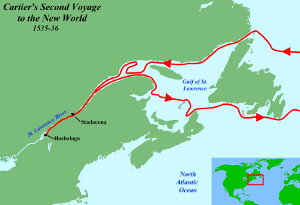Jacques Cartier: French Explorer of Canada
Jacques Cartier was one of France's most famous explorers of North America. He was one of the first Frenchmen to join the engage in the fur trade, and he is also credited with naming Canada. 
Jacques was born in Saint-Malo, on the Brittany coast, on Dec. 31, 1491. Not much is known of his early life, although the town was a hub of the fishing trade so he was no doubt familiar with ships and oceanic travels. The year after he was born, Christopher Columbus landed in the New World and claimed it for Spain. When Jacques was 27, he married Catherine de Granches, whose family had money and influence. He wasn't much of a stay-at-home man, though, and hungered for exploration across the seas. Some historians think that Cartier went along with Giovannia da Verrazzano on one if not two voyages to the New World, in 1524 and 1528. Some historians also think that Cartier traveled to Brazil at some point, mainly because he was quite proficient at speaking Portuguese. King Francis I of France wanted his country to keep pace with other European powers, who were sending explorers claim new lands known and hinted at across the Atlantic Ocean. Also at this time was prevalent the search for the fabled Northwest Passage, through the lands that Columbus had found, in a kind of shortcut to Asia. 
Cartier gained permission to lead a voyage of his own, and left Saint-Malo with two ships and 61 men on April 20, 1534. Twenty days later, they reached what is now Newfoundland. Cartier and his men sailed north for a time and then turned southward. They explored what is now the Gulf of St. Lawrence and, in June, discovered what is today Prince Edward Island. They continued to explore, making landfall again on what is now the Gaspé Peninsula and trading with friendly Native Americans, of the Mimac tribe; the two peoples traded furs and other items, and then Cartier's ships set sail again, becoming the first to sail completely around the Gulf of St. Lawrence. They set sail eastward and returned to Saint-Malo on September 5. 
King Francis was excited by Cartier's report and eagerly funded a return voyage. The second voyage led Cartier, with three ships and 110 men, left on May 19, 1535. They crossed the Atlantic Ocean without incident and arrived at what is now Funk Island, off the coast of Newfoundland. Striking inland, they explored more territory and encountered more Native Americans. On September 7, they reached the site of today's city of Quebec. At a village called Stadacona, the Huron chief, Donnaconna, extended greetings and sent some of his tribe as guides. Cartier and his men and the Huron guides sailed up the St. Lawrence River, reaching what is now Montreal (but what was then Hochelaga) on October 2. The Huron guides told Cartier of another place, called Saguenay, that was unreachable by the big French ships. Because of the impending winter, the French explorers returned to a fort that they built, St. Croix, at the mouth of the St. Charles River. They spent the winter there, waiting for the river ice to thaw. The winter was not kind to the Frenchmen, killing several from cold or scurvy. In April 1536, Cartier thought it safe to travel again. This time, he headed not west but east, homeward. Wanting proof of his discoveries, he kidnapped Donnaconna and his two sons and took them back to France. Europe was on fire with war at the time, and Cartier had to wait until 1541 before he got money, ships, and permission for a third expedition. On this voyage, Cartier took with him a nobleman, Jean-Francois de La Rocque de Roberval, whose task was to establish a permanent colony somewhere in the lands explored by Cartier. The king had named Roberval as the first lieutenant general of the French lands that Cartier had explored; in effect, Roberval outranked Cartier. Cartier set sail in August with five ships and again went as far as Hochelaga before settling in for another cold winter. Roberval, waiting for supplies, had not accompanied Cartier, and the latter would have to wait until spring for the former. Cartier's men managed to anger the local native Americans, and Cartier and his men took what they thought were a few loads of gold and diamonds and left. They stopped at Newfoundland, where they encountered Roberval, who wanted Cartier to turn around and lead him to Quebec. Cartier refused, setting sail for home in the dead of night. When he presented the "gold and diamonds" to the king, he discovered that they were, neither and were, in fact, worthless. (This gave rise to a French expression: "faux comme les diamanta du Canada," or "as false as Canadian diamonds.") As a result of this failure to bring back anything substantial and his abandonment of Roberval, he was not able to convince the king to send him on any new voyages. He spent his remaining years in Saint-Malo and died in 1557, having achieved his greatest successes early in his life. He is known for exploring the St. Lawrence River, the Gulf of St. Lawrence, and Newfoundland. He discovered Prince Edward Island. He is also said to have coined the word Canada, making it from a corruption of the Huron-Iroquois word kanata, meaning a village or a settlement. |
|
Social Studies for Kids
copyright 2002–2025
David White




